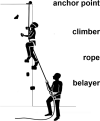A randomised controlled trial on effectiveness and feasibility of sport climbing in Parkinson's disease
- PMID: 34112807
- PMCID: PMC8192917
- DOI: 10.1038/s41531-021-00193-8
A randomised controlled trial on effectiveness and feasibility of sport climbing in Parkinson's disease
Abstract
Physical activity is of prime importance in non-pharmacological Parkinson's disease (PD) treatment. The current study examines the effectiveness and feasibility of sport climbing in PD patients in a single-centre, randomised controlled, semi-blind trial. A total of 48 PD patients without experience in climbing (average age 64 ± 8 years, Hoehn & Yahr stage 2-3) were assigned either to participate in a 12-week sport climbing course (SC) or to attend an unsupervised physical training group (UT). The primary outcome was the improvement of symptoms on the Movement Disorder Society-Sponsored Revision of the Unified Parkinson's Disease Rating Scale part III (MDS-UPDRS-III). Sport climbing was associated with a significant reduction of the MDS-UPDRS-III (-12.9 points; 95% CI -15.9 to -9.8), while no significant improvement was to be found in the UT (-3.0 points; 95% CI -6.0 to 0.1). Bradykinesia, rigidity and tremor subscales significantly improved in SC, but not in the unsupervised control group. In terms of feasibility, the study showed a 99% adherence of participants to climbing sessions and a drop-out rate of only 8%. No adverse events occurred. This trial provides class III evidence that sport climbing is highly effective and feasible in mildly to moderately affected PD patients.
Conflict of interest statement
The authors declare no competing interests.
Figures



Similar articles
-
Climb up! Head up! Climbing improves posture in Parkinson's disease. A secondary analysis from a randomized controlled trial.Clin Rehabil. 2023 Nov;37(11):1492-1500. doi: 10.1177/02692155231174990. Epub 2023 May 8. Clin Rehabil. 2023. PMID: 37157229 Free PMC article. Clinical Trial.
-
Vertical locomotion improves horizontal locomotion: effects of climbing on gait and other mobility aspects in Parkinson's disease. A secondary analysis from a randomized controlled trial.J Neuroeng Rehabil. 2024 Apr 27;21(1):63. doi: 10.1186/s12984-024-01363-4. J Neuroeng Rehabil. 2024. PMID: 38678241 Free PMC article. Clinical Trial.
-
A Phase II Study to Evaluate the Safety and Efficacy of Prasinezumab in Early Parkinson's Disease (PASADENA): Rationale, Design, and Baseline Data.Front Neurol. 2021 Oct 1;12:705407. doi: 10.3389/fneur.2021.705407. eCollection 2021. Front Neurol. 2021. PMID: 34659081 Free PMC article.
-
Effectiveness of home-based and remotely supervised aerobic exercise in Parkinson's disease: a double-blind, randomised controlled trial.Lancet Neurol. 2019 Nov;18(11):998-1008. doi: 10.1016/S1474-4422(19)30285-6. Epub 2019 Sep 11. Lancet Neurol. 2019. PMID: 31521532 Clinical Trial.
-
Efficacy of exercises in early-stage Parkinson's disease (PARK-EASE trial): single-blind, randomised, controlled trial.BMJ Neurol Open. 2023 Nov 14;5(2):e000499. doi: 10.1136/bmjno-2023-000499. eCollection 2023. BMJ Neurol Open. 2023. PMID: 38027470 Free PMC article.
Cited by
-
The Origin, Application and Mechanism of Therapeutic Climbing: A Narrative Review.Int J Environ Res Public Health. 2022 Aug 6;19(15):9696. doi: 10.3390/ijerph19159696. Int J Environ Res Public Health. 2022. PMID: 35955052 Free PMC article. Review.
-
Climb up! Head up! Climbing improves posture in Parkinson's disease. A secondary analysis from a randomized controlled trial.Clin Rehabil. 2023 Nov;37(11):1492-1500. doi: 10.1177/02692155231174990. Epub 2023 May 8. Clin Rehabil. 2023. PMID: 37157229 Free PMC article. Clinical Trial.
-
Vertical locomotion improves horizontal locomotion: effects of climbing on gait and other mobility aspects in Parkinson's disease. A secondary analysis from a randomized controlled trial.J Neuroeng Rehabil. 2024 Apr 27;21(1):63. doi: 10.1186/s12984-024-01363-4. J Neuroeng Rehabil. 2024. PMID: 38678241 Free PMC article. Clinical Trial.
-
Wearable Sensors and Motion Analysis for Neurological Patient Support.Biosensors (Basel). 2024 Dec 19;14(12):628. doi: 10.3390/bios14120628. Biosensors (Basel). 2024. PMID: 39727893 Free PMC article.
-
Parkinson's disease motor intervention patterns: a network meta-analysis based on patient motor function.Front Neurol. 2024 Sep 5;15:1432256. doi: 10.3389/fneur.2024.1432256. eCollection 2024. Front Neurol. 2024. PMID: 39314864 Free PMC article.
References
-
- Tomlinson, C. L. et al. Physiotherapy versus placebo or no intervention in Parkinson’s disease. Cochrane Database Syst. Rev., Cd002817, 10.1002/14651858.CD002817.pub2 (2012). - PubMed
LinkOut - more resources
Full Text Sources
Research Materials
Miscellaneous

